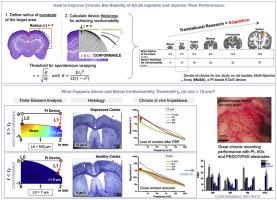Biomaterials ( IF 12.8 ) Pub Date : 2020-06-15 , DOI: 10.1016/j.biomaterials.2020.120178 Maria Vomero 1 , Maria Francisca Porto Cruz 2 , Elena Zucchini 3 , Francesca Ciarpella 4 , Emanuela Delfino 3 , Stefano Carli 5 , Christian Boehler 6 , Maria Asplund 7 , Davide Ricci 8 , Luciano Fadiga 3 , Thomas Stieglitz 9

|
Structural biocompatibility is a fundamental requirement for chronically stable bioelectronic devices. Newest neurotechnologies are increasingly focused on minimizing the foreign body response through the development of devices that match the mechanical properties of the implanted tissue and mimic its surface composition, often compromising on their robustness. In this study, an analytical approach is proposed to determine the threshold of conformability for polyimide-based electrocorticography devices. A finite element model was used to quantify the depression of the cortex following the application of devices mechanically above or below conformability threshold. Findings were validated in vivo on rat animal models. Impedance measurements were performed for 40 days after implantation to monitor the status of the biotic/abiotic interface with both conformable and non-conformable implants. Multi-unit activity was then recorded for 12 weeks after implantation using the most compliant device type. It can therefore be concluded that conformability is an essential prerequisite for steady and reliable implants which does not only depend on the Young's modulus of the device material: it strongly relies on the relation between tissue curvature at the implantation site and corresponding device's thickness and geometry, which eventually define the moment of inertia and the interactions at the material-tissue interface.
中文翻译:

基于聚酰亚胺的μECoG:将电极靠近信号源。
结构生物相容性是长期稳定的生物电子设备的基本要求。最新的神经技术越来越关注通过开发与植入组织的机械特性相匹配并模仿其表面成分的设备来最大程度地减少异物反应,这通常会损害其坚固性。在这项研究中,提出了一种分析方法来确定基于聚酰亚胺的皮质脑电图设备的合格性阈值。机械应用高于或低于合格阈值的设备后,使用有限元模型来量化皮质的凹陷。研究结果在体内得到验证在大鼠动物模型上。植入后进行了40天的阻抗测量,以监测适形和非适形植入物的生物/非生物界面状态。然后在植入后使用最兼容的设备类型记录多单元活动12周。因此可以得出结论,顺应性是稳定可靠的植入物的基本前提,它不仅取决于器件材料的杨氏模量:它强烈依赖于植入部位的组织曲率与相应器件的厚度和几何形状之间的关系,最终定义了惯性矩以及材料-组织界面处的相互作用。











































 京公网安备 11010802027423号
京公网安备 11010802027423号